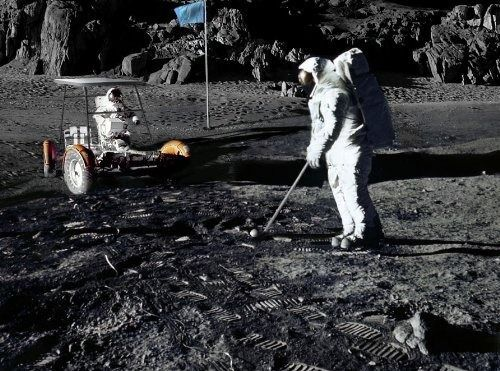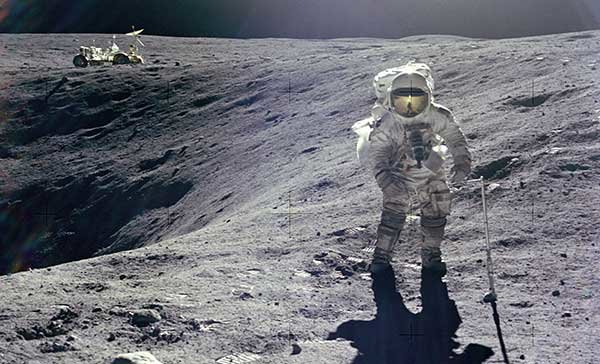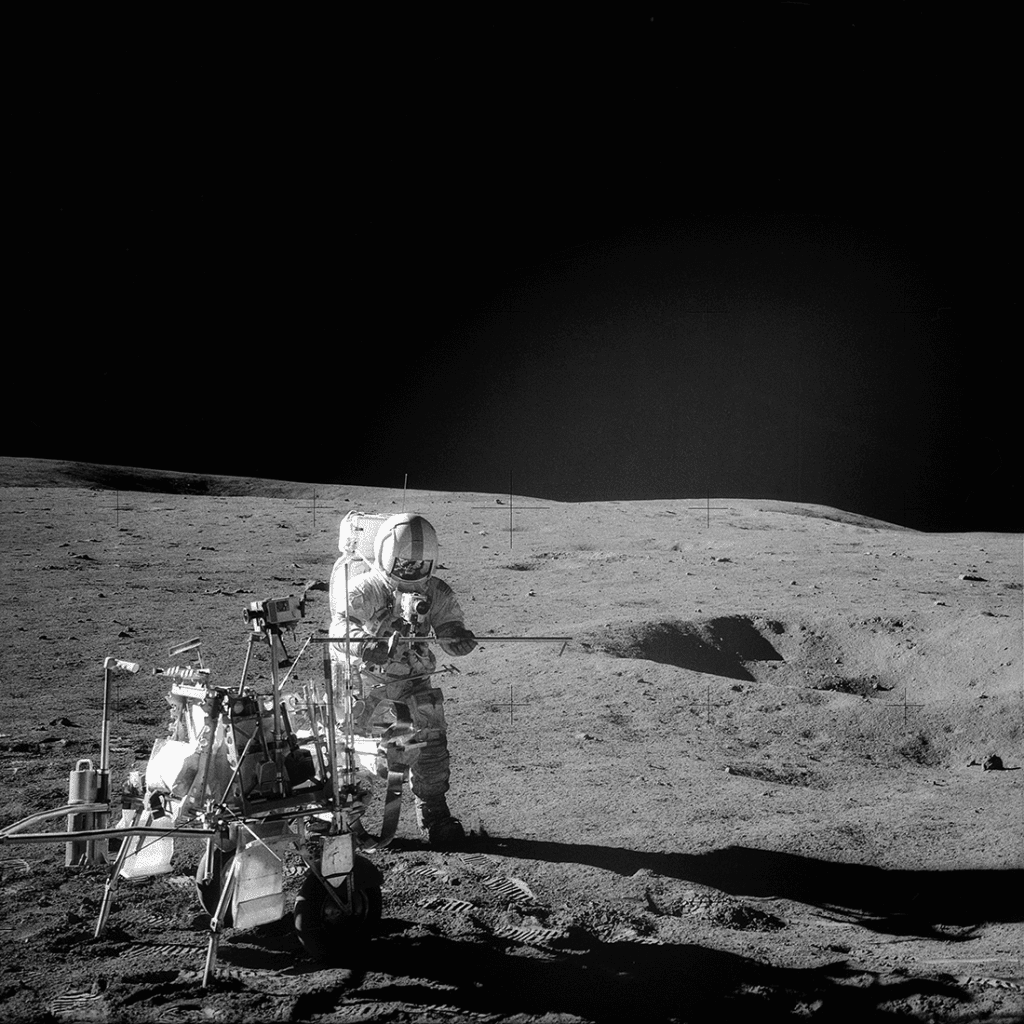On February 5, 1971, a remarkable chapter in space exploration unfolded as Apollo 14’s Lunar Module successfully touched down on the Moon, marking America’s third successful moon landing. Astronauts Alan Shepard and Edgar Mitchell made history as they set foot on the lunar surface, landing in the Fra Mauro formation a region rich in scientific potential. While the primary goal of the mission was to conduct groundbreaking scientific research, one unexpected event stood out in the annals of space history: Alan Shepard’s iconic golf shot. This lighthearted moment of creativity on the Moon captured the imagination of millions, symbolizing the true spirit of exploration. Apollo 14 not only advanced our understanding of the Moon but also furthered humanity’s reach into the cosmos.

Apollo 14: A Milestone in Lunar Exploration
Apollo 14 was a mission steeped in significance. Launched as part of NASA’s Apollo program, the mission’s primary objective was to explore the Fra Mauro region of the Moon. This area was chosen for its geological interest, as it was believed to have been formed by a large impact crater. Scientists were eager to learn more about the Moon’s history, and the Fra Mauro formation offered an excellent opportunity to study the effects of lunar impacts.

The Apollo 14 crew consisted of three astronauts: Commander Alan Shepard, Lunar Module Pilot Edgar Mitchell, and Command Module Pilot Stuart Roosa. While Roosa remained in lunar orbit aboard the command module, Shepard and Mitchell descended to the lunar surface in the Lunar Module, setting foot on the Moon for the first time in their mission. Their landing marked a significant step forward in humanity’s understanding of the Moon’s composition and geological history.
Video:
Apollo 14: ‘A Wild Place Up Here’
Alan Shepard’s Golf Shot: A Playful Moment in History
Amid the serious scientific work that defined Apollo 14, one event has forever captured the public’s imagination: Alan Shepard’s golf shot. Shepard, known for his sense of humor and creative thinking, took a break from his duties to perform a lighthearted stunt that would go down in history. He had smuggled a six-iron club on board, along with two golf balls, and decided to take a swing on the Moon’s surface.
With the Moon’s lower gravity and lack of atmosphere, the ball traveled much farther than it would on Earth. Although the shot was not the most scientifically significant moment of the mission, it was undeniably one of the most memorable. Shepard’s golf swing became a symbol of the creativity, joy, and human spirit that are intrinsic to exploration. It showed the world that even in the most serious endeavors, there is room for fun and imagination.

This iconic moment went viral in its own way, making headlines and instantly connecting millions of people on Earth to the monumental achievement taking place on the Moon. It was an uplifting reminder of humanity’s ability to maintain a sense of wonder, even when faced with the grandest challenges.
A Step Forward for Space Exploration
The Apollo 14 mission was more than just a scientific achievement it represented a giant step forward in humanity’s ability to explore space. Shepard and Mitchell’s work helped lay the foundation for future lunar missions and broadened the scope of our understanding of the Moon. By providing direct access to the Moon’s surface and its resources, Apollo 14 showcased the potential for human space exploration beyond Earth’s atmosphere.
The data collected during Apollo 14’s mission was crucial for planning future exploration efforts, including the subsequent Apollo missions. It also provided the necessary experience and lessons that would inform missions beyond the Moon, such as those aimed at Mars. The success of Apollo 14 demonstrated that humanity was capable of not only traveling to the Moon but conducting meaningful scientific research once we got there.

The Legacy of Apollo 14
The legacy of Apollo 14 goes far beyond the scientific samples and experiments. The mission demonstrated the power of human curiosity, determination, and creativity in the pursuit of knowledge. Shepard’s golf shot, though playful, encapsulated the larger theme of the Apollo program: a desire to push boundaries, challenge expectations, and explore the unknown.
Video:
The Computer Hack That Saved Apollo 1
Apollo 14’s success not only built upon the achievements of the previous Apollo missions but also set the stage for future exploration of the Moon and beyond. The mission solidified NASA’s position as a leader in space exploration and proved that humanity was capable of performing complex scientific tasks in space.
The mission also left a lasting impact on popular culture, with Shepard’s golf shot becoming a symbol of how space exploration can be both awe-inspiring and approachable. It showed that exploration doesn’t always have to be serious and solemn it can be fun and filled with moments of lightheartedness.
Inspiration for the Future of Space Exploratio
Apollo 14 serves as an enduring inspiration for the next generation of explorers, scientists, and engineers. The mission demonstrated that space exploration is not just about gathering data it’s about pushing the limits of what we can achieve as humans. From Shepard’s golf shot to the scientific discoveries made, Apollo 14 exemplified the spirit of exploration: bold, creative, and filled with potential.
As we look to the future, with the upcoming Artemis missions returning humans to the Moon and the continued ambition to explore Mars, Apollo 14 stands as a reminder of what is possible when we reach for the stars. Shepard and Mitchell’s journey to the Moon was not just a historic achievement; it was a beacon of inspiration for humanity’s future in space.

Conclusion: The Spirit of Exploration Lives On
Apollo 14 was more than just a mission it was a testament to human creativity, curiosity, and the relentless desire to explore. Shepard and Mitchell’s groundbreaking work on the lunar surface advanced our understanding of the Moon and laid the foundation for future space missions. At the same time, Shepard’s iconic golf shot remains a lighthearted symbol of the ingenuity and imagination that drive exploration.
As we continue to push the boundaries of space exploration, the legacy of Apollo 14 reminds us that even in the vast emptiness of space, there is room for fun, creativity, and the joy of discovery. The mission was a defining moment in humanity’s journey to the stars and continues to inspire future generations to look to the heavens and dream of new possibilities.


